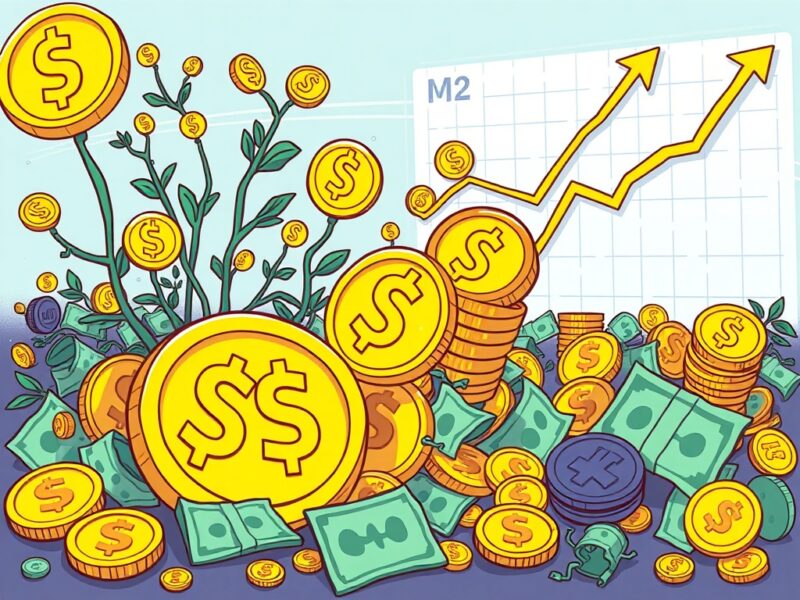Stablecoin M2 Money Supply: Remarkable Surge Doubles Market Share to 1.34%
0
0

BitcoinWorld

Stablecoin M2 Money Supply: Remarkable Surge Doubles Market Share to 1.34%
The financial world is witnessing a quiet but profound revolution. For the first time, the Stablecoin M2 money supply has doubled in just two years, now standing at a remarkable 1.34% of the total M2 money supply. This isn’t just a number; it’s a clear signal of how digital assets are increasingly integrating into the global economy, challenging traditional financial structures and offering new pathways for stability and growth.
Understanding the Stablecoin M2 Money Supply: What Does it Mean?
M2 money supply traditionally measures a country’s money in circulation, including cash, checking deposits, and easily convertible near money. The inclusion of stablecoins within this metric, as highlighted by Santora, signifies their growing legitimacy and utility.
Stablecoins are cryptocurrencies designed to maintain a stable value, often pegged to fiat currencies like the US dollar. Their stability makes them ideal for various financial transactions, bridging the gap between volatile cryptocurrencies and traditional banking.
This doubling of the Stablecoin M2 money supply share from approximately 0.67% to 1.34% within two years is a testament to their increasing adoption and trust. It reflects a significant shift in how we perceive and utilize digital assets in the broader financial ecosystem.
Why the Stablecoin M2 Money Supply is Surging: Key Drivers
Several factors contribute to this impressive surge in the Stablecoin M2 money supply. These drivers highlight the evolving needs of both individual users and large financial entities.
- DeFi Expansion: Stablecoins are the lifeblood of DeFi, enabling lending, borrowing, and trading. As DeFi grows, so does the demand for stable, digital collateral.
- Efficient Cross-Border Payments: Stablecoins offer a faster, cheaper alternative to traditional international wire transfers, bypassing legacy banking systems and reducing transaction costs.
- Inflation Hedging: In economies facing high inflation, dollar-pegged stablecoins can offer a refuge, preserving purchasing power digitally.
- Evolving Regulatory Landscape: Increased regulatory attention brings clarity and legitimacy, encouraging institutional adoption and broader public trust.
Challenges and Opportunities for the Stablecoin M2 Money Supply
Despite the rapid growth of the Stablecoin M2 money supply, the path ahead isn’t without its hurdles. Understanding these challenges and opportunities is crucial for sustained development.
Challenges include:
- Regulatory Scrutiny: Governments are grappling with how to regulate stablecoins, balancing innovation with consumer protection. Inconsistent global regulations pose a significant hurdle.
- Systemic Risk Concerns: The size and interconnectedness of stablecoins with traditional finance raise questions about potential systemic risks if a major stablecoin were to de-peg.
- Transparency and Auditing: Ensuring stablecoins are truly backed 1:1 by reserves requires robust auditing and transparent reporting, an area of ongoing development.
Opportunities, however, are immense:
- Financial Inclusion: Stablecoins can provide essential banking services to the unbanked globally, offering access to digital payments and savings.
- Innovation in Payments: They are paving the way for programmable money, instant settlements, and new business models leveraging blockchain technology.
- New Financial Rails: Stablecoins are forming new digital financial infrastructure, lowering costs and increasing efficiency. Companies like Circle (USDC) and Tether (USDT) exemplify this.
The remarkable doubling of the Stablecoin M2 money supply share to 1.34% is more than just a statistic; it’s a testament to a pivotal financial paradigm shift. Stablecoins are no longer a niche crypto product but a significant, growing component of the global monetary landscape. Their continued evolution promises a future where digital and traditional finance are increasingly intertwined, offering unprecedented efficiency and access. Monitoring this trend will be vital for anyone involved in finance, technology, or policy-making. The journey of stablecoins is far from over, and their impact on the global economy is only just beginning to unfold.
Frequently Asked Questions (FAQs)
What is M2 money supply?
M2 is a broad measure of a country’s money stock, including cash, checking deposits, savings, and easily convertible near-money assets.
What is a stablecoin?
A stablecoin is a cryptocurrency designed to maintain a stable value, usually pegged to a fiat currency like the US dollar.
Why are stablecoins included in M2 discussions?
Stablecoins are increasingly recognized as a liquid, widely accepted medium of exchange, making their inclusion relevant for understanding the total money supply.
What are the main benefits of using stablecoins?
Benefits include price stability, faster international transactions, and access to decentralized finance (DeFi).
If you found this article insightful, consider sharing it with your network! Help us spread awareness about the transformative role of stablecoins in the global financial landscape on social media.
To learn more about the latest crypto market trends, explore our article on key developments shaping digital finance institutional adoption.
This post Stablecoin M2 Money Supply: Remarkable Surge Doubles Market Share to 1.34% first appeared on BitcoinWorld and is written by Editorial Team
0
0
 Manage all your crypto, NFT and DeFi from one place
Manage all your crypto, NFT and DeFi from one placeSecurely connect the portfolio you’re using to start.




